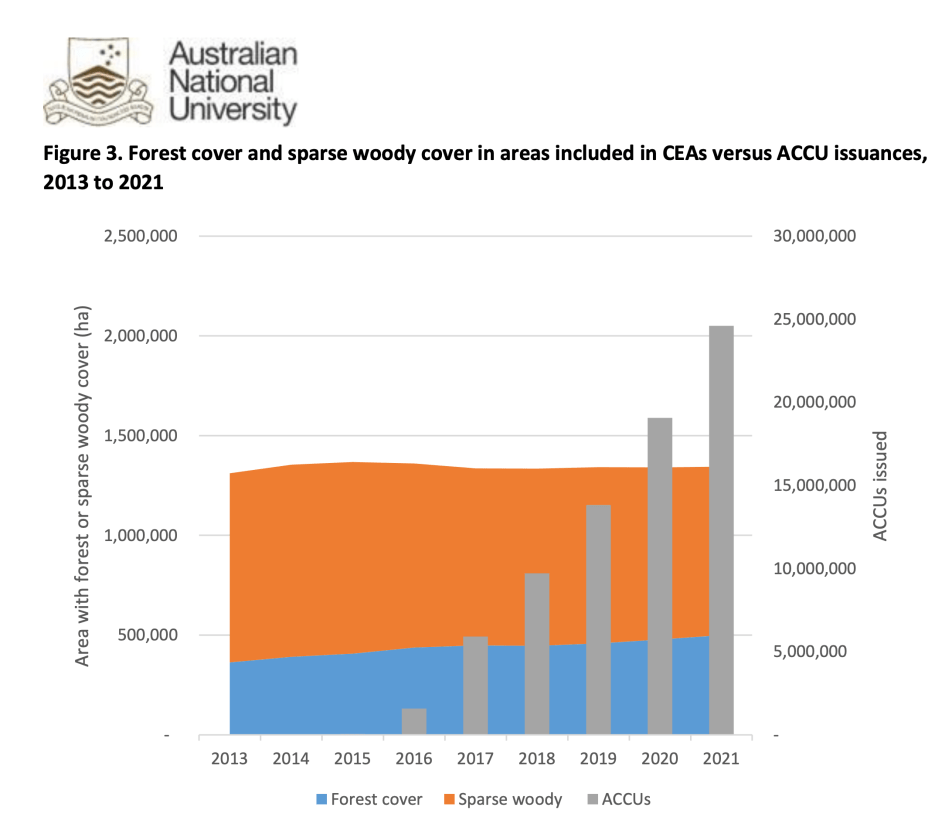
Critics of Australia’s carbon credits system have been vindicated by a new study confirming that millions of carbon credits issued for rural tree-regeneration projects under the Coalition are worthless — demolishing the findings of a government review that found nothing wrong with the existing system.
The study, by ANU’s Professor Andrew Macintosh, is based on new data that the discredited Clean Energy Regulator (CER) released earlier this month, which examines actual levels of tree cover in areas for which Australian Carbon Credit Units (ACCUs) have been issued for vegetation regeneration. In 2021, Macintosh first blew the whistle on the worthlessness of a huge proportion of ACCUs, and was savaged by the Morrison government and the CER for questioning their value.
Handing out ACCUs for carbon sequestration projects like regeneration — supposed to provide additional carbon abatement on top of business-as-usual land management practices — provided a cover for the Coalition’s climate inaction and funnelled tens of millions of dollars in assets to the National Party’s constituency and a growing industry of intermediaries.
The new government commissioned a review led by Professor Ian Chubb last year that dismissed criticisms as based on insufficient data about accredited projects, and declared the system “fundamentally well-designed”.
One positive outcome from the Chubb review, however, was that legislation was changed to require the CER — which has made incoherent defences of ACCUs and been forced to apologise for abusing critics — to release detailed information about the human-induced regeneration (HIR) projects that form the basis for a large volume (around 30%) of ACCUs.
The CER wants to portray the release of the information as “an important step towards a more informed market and increased trust and confidence in the drawdown of CO2 at scale within Australia’s path to net zero” — but then contrarily insists the data “will not be sufficient (in of itself) to make a judgment about the performance of ACCU scheme projects”.
But the data allows Macintosh and his team to examine hundreds of HIR projects in detail using the same satellite imagery used to calculate land sector emissions for Australia’s reporting under the UN Framework Convention on Climate Change National Inventory Report.
HIR projects — the most popular type of ACCU — involve a total of 31 million hectares of woodland across Australia that is “regenerating”, not through planting trees but by removing grazing pressure and pests, allowing vegetation to reestablish and spread.
The problem with HIR projects is that they often involve woodland that hasn’t been cleared at all in the first place, thus reducing or eliminating the possibility of additional sequestration through increased vegetation on top of what is already present. Moreover, the eponymous “regeneration” may never actually occur at a level additional to what would otherwise have occurred, despite credits being awarded.
The new data confirms that virtually no regeneration occurred in 192 of the 219 projects for which the CER released data. More than 80% of the project areas were never cleared more than 10% in the first place; more than half of the project areas had negligible clearing at all.
Satellite imagery shows how much regeneration has really occurred: over the period during which the project was accredited, there was an increase in vegetation cover in just 36, or 19%, of the projects examined. In nearly 40% of projects, there was no change in cover at all. In a remarkable 42% of projects, representing 15 million ACCUs, vegetation cover actually fell.
The disparity is stark between the ACCUs issued and the actual amount of vegetation coverage that supposedly provides a sound foundation for the credits.

The study identifies projects that do see substantial increases in coverage. The Arbon-Tooligie Human-Induced Regeneration project in South Australia showed a 37% increase in coverage, meaning the ACCUs issued for it reflect a very similar trajectory to the level of vegetation. But that is almost unique among the nearly 200 projects examined.
The data also shows that changes in vegetation in project areas were almost identical to changes in nearby woodland that were not included in the projects, suggesting permits were being issued simply for vegetation changes that were occurring naturally.
Overall, the study finds, there was zero total net change in overall tree cover in project areas. Only around 6.5 million of the 34 million ACCUs issued for the projects applied to areas that saw any kind of increase. The remaining 27 million-plus credits were worthless. There was no carbon abatement, no sequestration, no soil magic.
Those credits continue to circulate now, used by heavy carbon polluters to “offset” their own output, or plug accounting holes in failed carbon capture and storage projects. Post-Chubb, the ACCU system is as rotten as ever.








people and corporations rorting programs (supposedly) designed to mitigate the oncoming Climate Catastrophe, should be dealt with like enemy-collaborators in war time — humanity is facing an existential crisis and these grifters are feathering their nests – sickening
We would be lining a lot of society’s “lifters” up against a wall.
Someone show me the path from here to there.
Lifting, a synonym for the old half inch.
What we all knew, or strongly suspected. Yet another in a long line of rorts, channeling taxpayers’ money to the National Party faithful. Could there be legal action taken against those claiming these bogus carbon credits? Gosh, no, Frank; that would be socialism.
And having a neuroscientist, well embedded in the political, business and academic establishment, heading a review that seems to be more about ‘business as usual’ to support the ongoing gaming of systems and processes by the top end of town; who would have thought?
Well, if the government knew from the start that off-sets are complete bollocks then we should get an instant, shocked response to this research followed by a sincere apology and a promise to do away with this farce and take real action. Of course there’s zero chance of this happening and yet again we’ve got government telling us lies with complete contempt for what we want [and what we voted for].
What we voted for was the Voice and the NACC (ultimately nobbled by collusion with Dutton). Labor really offered nothing else, including scrapping of Liberal policies. We got exactly what was promised.
Labor did offer the 43% reduction target and it was reported at the time that Albanese had managed to lift that from 40% against the will of many in the party. As it’s turned out the target was complete bs with no real reductions other than the off-sets. Where the Libs dance to the ideological extremism of the IPA, the only ideology that’s coming out of Labor is their desire to do what it takes to stay in power for several terms.
To introduce market mechanisms for something this complex and hard to quantify is to just invite grifters. Markets seek something-for-nothing as surely as water flows downhill. Screw markets in offsets. Bring back the carbon tax. It’s the only damned thing that has actually worked — which is exactly why the polluters and their political wing (i.e. the Libs and Nats) hated it so much.
If Australia had a well resourced national broadcaster staffed by highly competent journalists who were supported by senior management and a chair who lead their mission with vision and drive, this farcical sham would be exposed in a way that ordinary Australians could comprehend. People would talk about it at work. They would demand change.
Instead, in 2023, they’re retweeting Kardashian, Musk, Jay-Z and Trump on Twitter.
Seems like not all that long ago, when Four Corners would routinely justify the whole ABC budget by itself…
If Australia had a democratically elected representative government that isn’t totally co-opted by the fossil fuel, gambling, mining, and real estate lobbies, the inadequacies of our ABC wouldn’t matter.